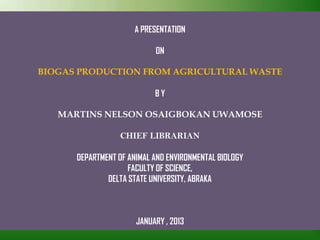
Presentation on Biogas Production from Agricultural Waste
- 1. A PRESENTATION ON BIOGAS PRODUCTION FROM AGRICULTURAL WASTE B Y MARTINS NELSON OSAIGBOKAN UWAMOSE CHIEF LIBRARIAN DEPARTMENT OF ANIMAL AND ENVIRONMENTAL BIOLOGY FACULTY OF SCIENCE, DELTA STATE UNIVERSITY, ABRAKA JANUARY , 2013
- 2. Waste has always been the shadow side of an economy. Waste is that which is rejected, useless and barren. It can also be called garbage, rubbish, refuse waste or whichever language you call it they are the same. Additionally, waste includes all items that people no longer have any use for wish they either intend to get rid of or already discarded. Thus all our daily activities can give to a large variety of different wastes arising from different sources. The more waste we generate, the more we have to dispose to them, but they can be recycled into raw materials to produce biogas. Biogas is a renewable energy source, like solar and wind energy. Waste recycling offers one means of reducing the impact of waste disposal in the atmosphere. Biogas is produced from easily available raw materials such as recycled waste and is environmentally friendly.
- 3. Agricultural waste, which includes both natural (organic) and non-natural wastes, is a general term used to describe waste produced on a farm through various farming activities. Agricultural and food industry residues refuse and wastes constitute a significant proportion of worldwide agricultural productivity. It has variously been estimated that these wastes can account for over 30% of world wide agricultural productivity. When discharged to the environment, agricultural wastes can be both beneficial and detrimental to living matter. Examples of such agricultural wastes include pineapple peels, plantain peels, mango peels, and cassava peels, and so on. Agricultural waste derived from animal agriculture and farming activities are to used for production of biogas.
- 4. Biogas typically refers to a gas produced by the biological breakdown of organic matter in the absence of oxygen. Biogas originates from biogenic material and is a type of biofuels. One type of biogas is produced by anaerobic digestion or fermentation of biodegradable materials such as biomass, manure or sewage, municipal waste, green waste and energy crops. This type of biogas comprises primarily of methane and carbon dioxide. Biogas technology is based on the phenomenon that when organic matter containing cellulose is fermented in the absence of air (aerobically), combustible gases but majorly (methane) is formed.
- 6. MATERIALS Pineapple Peels Plantain Peels Cassava Peels Distilled Water APPARATUS Measuring cylinders Beehive for gas collection Infrared thermometers Retort Stand Biogas Digester
- 7. Fig 1. Biogas Digester Source: Google Images Fig 2. Infrared Thermometer Source: Google Images Fig. 1 Fig. 2
- 8. Allow the agricultural waste to undergo partial decomposition in a compost arrangement with addition of bio enzymes and water. The partially decomposed waste should then be introduced into the digester (Fig. 1). Seal the digester completely and then connect to the gas delivery setup, the gas is going to be collected over water in a trough with a beehive and measuring cylinder. Leave the setup for a specific time period (precisely 1-6 days) at an ambient condition until a decline in gas production is observed. During the period of the production, the temperature displaced by gas should be measured daily using the infrared thermometer (Fig 2). The contents of the digester should be continuously stirred to ensure that the molecules of gas are set in perpetual random motion.
- 9. Biogas is used for heating. Biogas energy is used to generate power. Biogas is used as vehicle fuel. Biogas is used in industry such as sugar refineries, distilleries, dairies, and paper mill generate processing and waste water that can be digested on site. It can also be used for heating ovens.
- 10. Biogas production is often suggested in situations where agricultural wastes are used as a major source of household energy. The potential advantages include: The replacement of an inefficient (but traditional) fuel with a more efficient and flexible one, the recoupment of the fertilizer value of the waste, which is lost if the waste are burned and the benefits to public health (especially in reducing eye diseases) less Smokey, gas is used. Biogas is an attractive fuel for use in engines since it has no difficult pollutant that can damage them (like producer gas does).
- 11. Slide Designed By Martin Uwamose
